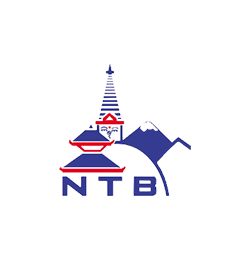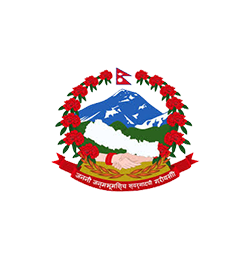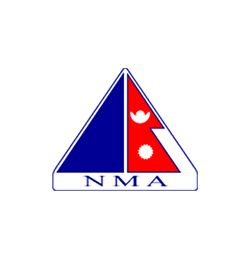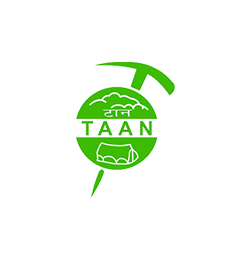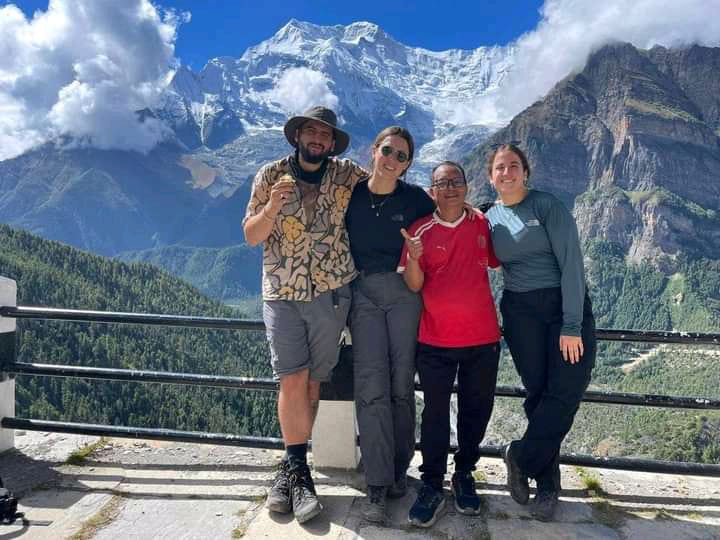
Annapurna Circuit Trek
The Annapurna Circuit Trek is one of the most celebrated trekking routes in the world. It is famous for its diverse landscapes, rich cultural immersion, and stunning mountain vistas all along the trail. This trek is located in the central region of Nepal and is known to provide a comprehensive Himalayan experience. As you pass through diverse landscapes that range from lush subtropical forests to picturesque terraced fields, and arid landscapes, each day provides a new experience during the Annapurna Circuit Trek. This trek usually spans 14-21 days, covering a distance of approximately 160-230 kilometers (100-145 miles), depending on the starting and ending points chosen by trekkers.
The other reason for Annapurna Circuit being a popular option is the level of personalization one can bring into this trek. The journey begins in Besisahar, following a drive from Kathmandu. From Besisahar where the trekking starts, trekkers gradually ascend through the Marshyangdi Valley, passing through charming Gurung villages. The highest point of this trail is Thorong La Pass (5,416 meters), which is considered the highest trekking pass in the world, making it the highlight and strenuous part of the trek. The Thorong La Pass is known to provide some of the best panoramic views of Annapurna, Dhaulagiri, and other towering peaks
Reaching Thorong La Pass and descending from there trekkers enter the Mustang region. The Mustang region is characterized by its unique Tibetan culture and dry, desert-like landscapes. It is also home to the Muktinath Temple, a sacred pilgrimage site for both Hindus and Buddhists. The Annapurna Circuit Trek usually concludes in Jomsom, with a flight back to Pokhara, or if you wish to continue you can extend through the beautiful landscapes of Ghorepani, and witness magnificent sunrise from Poon Hill.
Throughout the trek, trekkers experience the warm hospitality of the local communities especially Gurungs in the Annapurna region. The culture is diverse as you move from Hindu-dominated lower regions to Buddhist influence areas higher up. You stay at teahouses run by local families, creating perfect opportunities to connect with the locals, understand their way of life, and try local cuisines.
The Annapurna Circuit Trek is not just a physical journey, but also a spiritual and cultural odyssey. With great landscapes and breathtaking views along the trail, Annapurna Circuit is one trek that strengthens your connection with nature. With the ever-changing scenery, from blooming rhododendrons to high-altitude deserts, this trek remains a top choice for adventurers seeking a comprehensive Himalayan trekking experience.
Annapurna Circuit Trek Highlights
- Stunning panoramic views of Annapurna, Dhaulagiri, and other Himalayan peaks.
- Cross the challenging Thorong La Pass at 5,416 meters.
- Experience the unique cultures of the Annapurna, Manang, and Mustang regions.
- Visit the sacred Muktinath Temple, a pilgrimage site for Hindus and Buddhists.
- Enjoy hot springs at Tatopani, providing relaxation after days of trekking.
- Witness the breathtaking sunrise over the Himalayas from Poon Hill.
- Diverse landscapes, ranging from subtropical forests to arid high-altitude deserts.
- Interact with local communities and fellow trekkers from around the globe.
Best Season and Weather Climate
Choosing the right season for the Annapurna Circuit Trek is the key to having the perfect experience. You not only get magnificent views of the Himalayas but also ensure your safety at the same time. The weather in the Himalayas is rapidly changing, and conditions can get rough sometimes, thus planning your trek during the best seasons is very essential.
Spring Season (March to May):
Spring is the best time to trek the Annapurna Circuit. The weather is stable and temperatures are mild ranging from 10°C to 20°C at lower altitudes and cooler temperatures at higher elevations. The trails in spring get decorated with blooming rhododendron that adds to the beauty of the whole trip. The clear skies during Spring provide excellent visibility of the Himalayan region.
However, during spring the flow of trekkers is high as everyone chooses this season to trek. This results in scarce accommodation services making it essential to pre-book your teahouses.
Autumn Season (September to November):
Autumn is another ideal time for trekking the Annapurna Circuit. The skies are clear, and the crisp air after pre-monsoon allows breathtaking views of the Annapurna region. Temperatures are moderate, ranging from 5°C to 15°C, making it comfortable for trekking. Autumn also coincides with major festivals of Nepal like Dashain and Tihar, providing cultural treats for trekkers.
Monsoon Season (June to August):
The monsoon brings heavy rainfall, making the trails wet and slippery. The risk of landslide increases making it not a recommended season to trek on. The views are often obstructed by clouds and fog, and the risk of leeches is high.
Winter Season (December to February):
Winter can bring extreme temperatures in higher altitudes. With an average temperature ranging from -5°C to -20°C, it is impossible to trek on. Moreover, the Annapurna region experiences heavy snowfall, often obstructing the trail making it impossible to continue. Only experienced and well-prepared trekkers should trek in winter.
Annapurna Circuit Trek Trails
The Annapurna Circuit trek starts from Beshisahar, following the Marsyandi River and passing through lush forests. You move on through terraced fields and charming Gurung villages. As the trail ascends, you get to experience a transition of the landscape into alpine meadows and arid landscapes. You pass through some Key stops like Chame, Pisang, and the beautiful Manang Valley, where trekkers spend an extra day for acclimatization.
The most challenging part of this trek is the Thorong La Pass at 5,416 meters, which is known to offer stunning views of the Annapurna and Dhaulagiri ranges. The descent from the pass takes you to Muktinath, a sacred pilgrimage site for Hindus and Buddhists. The trail continues to Jomsom, where most trekkers end their journey with a flight to Pokhara.
However, for those who wish to continue, the trek extends to Tatopani, famous for its relaxing natural hot spring. From there, trekkers trek through Ghorepani and experience the stunning sunrise over the Annapurna Region. The trek concludes in Nayapul, followed by a drive to Pokhara, a lakeside city perfect for relaxation.
Annapurna Circuit Trek Difficulty
The Annapurna Circuit Trek is considered moderately difficult to strenuous. The risk of altitude sickness remains high even though you ascend gradually so following all the necessary precaution is expected from trekkers. The Annapurna Circuit Trek requires a good level of physical fitness, with some prior trekking experience. The most challenging part of this trek is the Thorong La Pass at an altitude of 5,416 meters where the risk of altitude sickness is very high.
You must be familiar with trekking for about 5-8 hours daily, while there are few acclimatization points along the way, being physically fit is a must. You walk through various terrain where prior trekking experience may be useful. The trail consists of steep ascents and descents, a rocky path, and an occasional icy trail which also requires mental toughness.
On average, the Annapurna Circuit Trek lasts about 17+ days, making it a challenging yet fun experience to indulge in. Despite the set of challenges, the Annapurna Circuit Trek is achievable for those with basic fitness and a strong determination. You must have sufficient knowledge about the trail and should have a guide for the best experience. Guided treks with reputable agencies like White Hill Adventure provide valuable support and help you navigate through the difficulty with ease.
Annapurna Circuit Trek Accommodations
Accommodations along the Annapurna Circuit Trek are primarily teahouses and lodges. However, the accommodation services in Annapurna Circuit are surely one step above other treks in Nepal. Teahouses offer basic yet comfortable facilities providing warm beds and meals to recharge after a day’s trek. These teahouses are run by local families, which provides an opportunity to connect with the locals and learn about their culture.
Most teahouses have twin sharing rooms with a shared bathroom. While the facilities are basic, teahouses often include a cozy dining hall with a wood-burning stove, creating a warm and social atmosphere to rest after an exhausting day.
In lower altitudes, towns like Chame and Manang offer more comfortable accommodation services with private rooms and attached bathrooms. As you ascend with altitude, the facilities become more basic with less number of teahouses and limited meal options. The teahouse owners are usually friendly allowing you to experience the local hospitality that adds a unique charm to the Annapurna Circuit.
Food and Restaurants
Food on the Annapurna Circuit Trek is generally nutritious and energy-packed, essential for being physically strong throughout the trek. Teahouses and lodges are scattered along the way, offering a variety of local and international dishes. More often the most popular dish while trekking the Annapurna Circuit is traditional Nepalese cuisine Dal Bhat (lentil soup with rice).
Breakfast typically includes items like pancakes, porridge, eggs, and Tibetan bread, which are all packed with nutrition. Mostly lunch and dinner consist of Dal Bhat, but there remains an option such as noodles and momo in some cases. Trekkers particularly prefer Dal Bhat as it is perfect for energy boosting and keeping you healthy.
With larger and more developed villages like Manang and Jomsom, the menu expands to international cuisine. With great restaurants and cafes in these villages, you can enjoy chow mein, pasta, and even pizza. There are also great bakeries offering fresh bread, pastries, and coffee.
As you ascend to higher altitudes, the variety of food decreases, and the prices increase due to the difficulty of transporting supplies. While on the Annapurna Circuit, it is recommended to try traditional Sherpa dishes such as shakpa (Sherpa stew), thukpa (noodle soup), and tsampa (roasted barley flour). These dishes are high in nutrition required for high-altitude trekking.
Since the teahouses in the trail are spaced several hours apart, you must carry high-energy snacks for the trail. Snacks like nuts, protein bars, chocolates, and dry fruits are recommended. These snacks help to maintain energy levels between meals, especially during long trekking hours.
Safety and Emergency Procedures
Safety becomes the primary consideration when trekking the Annapurna Circuit Trek. With Nepal’s recent law, requiring guides for high-altitude training, having an experienced guide by your side is very crucial. Certified guides from trekking agencies like White Hill Adventure ensure your safety, provide valuable insights, and enhance your overall trekking experience.
The Annapurna Circuit’s greatest challenge and safety concern is Altitude Sickness, for most people the symptoms start to show at 3000 meters above sea level. Trekkers should be well educated about the symptoms and prevention of altitude sickness. Proper acclimatization schedules and good hydration are the keys to having a safe trek. Look out for symptoms like headaches, dizziness, and nausea. Descending on a safer altitude is the best bet for remaining safe in severe cases.
In case of emergencies, White Hill Adventure offers evacuation services for the safety of our customers. Helicopter evacuations are available, though costly as flying at such a high altitude comes with great risks too. Thus, you should have travel insurance that covers high-altitude trekking and evacuations.
Preparation, proper acclimatization, and awareness of the risks are key to a safe and enjoyable trekking experience.
Culture, Wildlife, and Nature
The Annapurna Circuit Trek is a unique blend of cultural diversity, rich wildlife, scenic landscapes, and breathing vistas of the great Himalayas. As trekkers move through various altitudes, each day unfolds new possibilities and adventures in the Annapurna Circuit. Annapurna Circuit is primarily inhabited by the Gurung, Thakalai, and Manangba people each having their own set of traditions and culture.
The lower regions are predominantly Hindu, whereas the higher region has strong Tibetan Buddhist influences, visible by the monasteries, prayer flags, and chorten that decorate the landscapes. Trekkers stay in teahouses primarily run by locals, which is the best way to connect with the families and learn their way of life.
The wildlife inside the Annapurna Conservation Area is equally diverse and stunning, with the rare sight of the colorful Impeyan pheasant, the national bird of Nepal. Moreover, mammals such as langur monkeys, blue sheep, and occasionally the endangered snow leopard in higher altitudes. The Annapurna Conservation Area is a beautiful place that helps to preserve these species and their natural habitats.
Throughout the trek, Nature’s grandeur is on full display. The trail begins in lush subtropical forests, covered with rhododendrons in springs. As the altitude increases, the landscape transitions to alpine meadows and eventually to the barren high-altitude desert. The dramatic change in landscapes and nature is seen every day throughout the trail.
The combination of cultural richness, diverse wildlife, and the stunning beauty of the Annapurna Circuit makes it a complete Himalayan trekking experience.
Annapurna Circuit Trekking Preparation Tips
Preparing for the Annapurna Circuit requires careful planning and physical conditioning of the body. Being a longer trek that spans more than 2 weeks, this trek requires planning and considering things that can go wrong. Here are some essential tips to consider:
- Physical Training: Start your training session at least 2-3 months before the trek. Focus primarily on Cardiovascular exercises such as running, cycling, and swimming to build up stamina.
- Acclimatization: Altitude sickness is a real deal, proper acclimatization plans and rest days in your itinerary are crucial for a safe trip. Stay hydrated, avoid alcohol, and ascend gradually.
- Gear and Equipment: Make sure to invest in high-quality trekking gear. Sturdy, broken-in trekking boots, suitable clothing, a trekking pole, a good sleeping bag, and a reliable backpack are some of the essentials.
- Permits and Documentation: Obtain all the necessary permits, such as the Annapurna Conservation Area Permit (ACAP) and the Trekkers’ Information Management System (TIMS) card for the Annapurna Circuit Trek. Make sure to keep copies of your passport, visa, and travel insurance. Joining hands with a reputable trekking agency like White Hill Adventure can secure all the documents and permits for you. This allows you to have a smooth trekking experience.
- Health and Safety: Carry a first aid kit, personal medication, and water purification tablets.
- Mental Preparation: Be mentally prepared for long trekking days in high altitudes. The accommodations are basic and the weather is unpredictable. Try to maintain a positive attitude throughout the trek.
For a more comprehensive trekking preparation, you can connect with White Hill Advisors here (insert link). Our team members are happy to assist you.
Photography Opportunities on Annapurna Circuit
The Annapurna Circuit Trek offers some of the most stunning landscapes to capture great memories. The unparalleled photography opportunity allows you to capture the essence of the Himalayas in all its glory. The diverse landscapes ranging from lush forests to high arid desert, provide a dynamic photography experience.
The majestic Annapurna and Dhaulagiri mountain ranges can be seen all along the trail, giving you plenty of opportunities to capture its beauty. Moreover, key spots like Thorong La Pass and Poon Hill offer great panoramic views, a real haven for photographers. In addition to the beauty of the whole region, the cultural essence can be captured as well, ethnic villages, unique architecture, and vibrant festivals all add to a dynamic photography experience.
High-altitude areas, with minimal light pollution, are perfect for astrophotography, allowing you to see the majestic Milky Way galaxy at its finest. The Annapurna Circuit Trek is one of the best trails full of photography options.
Note: While in high-altitude regions, make sure to look out for your battery life, as charging facilities may not be available at all teahouses. Thus, carrying extra batteries and a power bank is essential to not miss out on capturing great moments.
Outline Itinerary with Height and Trek Hours
Day 1: Arrival in Kathmandu (1,400m)
Day 2: Drive to Besisahar (820m) – 6-7 hours
Day 3: Trek to Chamje (1,410m) – 5-6 hours
Day 4: Trek to Dharapani (1,960m) – 5-6 hours
Day 5: Trek to Chame (2,710m) – 5-6 hours
Day 6: Trek to Pisang (3,300m) – 5-6 hours
Day 7: Trek to Manang (3,540m) – 5-6 hours
Day 8: Acclimatization Day in Manang
Day 9: Trek to Yak Kharka (4,020m) – 3-4 hours
Day 10: Trek to Thorong Phedi (4,450m) – 3-4 hours
Day 11: Cross Thorong La Pass (5,416m) to Muktinath (3,800m) – 7-8 hours
Day 12: Trek to Jomsom (2,720m) – 5-6 hours
Day 13: Trek to Tatopani (1,190m) – 6-7 hours
Day 14: Trek to Ghorepani (2,850m) – 7-8 hours
Day 15: Hike to Poon Hill (3,210m), trek to Nayapul, drive to Pokhara (820m) – 6-7 hours
Day 16: Drive back to Kathmandu – 6-7 hours
Day 17: Departure
Solo Traveler and Group Options for Annapurna Circuit Trek
Solo travelers and group trekkers have completely different experiences on the Annapurna Circuit. Solo trekking offers you a sense of freedom and personal achievement, here you get to connect with nature to the fullest. However, problems such as navigation of the trail, potential safety issues, and logistics may take a lot of work to manage. Recently, with Nepal’s new law, all trekkers and hikers must have a guide with them. This ensures that solo travelers are safe and well-supported throughout the trek.
While trekking with groups, on the other hand, provides companionship and support. It is a great way to connect with your loved ones and make an experience that lasts a lifetime. Trekking with groups can be enriching and comforting in remote and challenging environments. Groups usually have guides and porters with shared prices, thus enhancing the trekking experience.
With White Hill Adventure, you get the options of both solo adventure and group trek. For both solo travelers and group trekkers, we ensure personalized attention and safety regulations for a smooth trekking experience.
Personalized Support, Customer Care, and Responsible Tourism
White Hill Adventure is dedicated to providing personalized support and exceptional customer care, ensuring a smooth experience. With White Hill Adventure and the experienced set of guides we offer, you are safe 24/7 with us. From the moment trekkers book their trip, our team offers tailored advice and support. This includes pre-trek befriends, detailed itineraries, custom itineraries, and 24/7 customer service.
Guides are selected based on their expertise, and each guide possesses extensive knowledge about the terrain, culture, and safety protocols. Our guides are fluent in English and friendly for friendly assistance throughout the trek.
The well-being of trekkers becomes the top priority. With White Hill Adventure you get safety protocols such as proper acclimatization schedules, and emergency measures. Our guides are well-trained in first aid and equipped with communication devices to handle emergencies efficiently. Accommodations and meals are made with careful attention to comfort and hygiene for a smooth and safe trekking experience.
White Hill Adventure is committed to sustainable and responsible tourism practices. Our team works closely with the local communities to organize a cleaning campaign and to promote cultural exchange. White Hill Adventure also focuses on economic benefits for the region, as we employ local guides and porters. The company believes in eco-friendly practices and aims to minimize carbon footprint in each trip we make.
By prioritizing personalized support, excellent customer care, and responsible tourism, White Hill Adventure aims to provide a rewarding experience for trekkers who want to explore the great Himalayas.
Guide certifications and Experience
With the growing tourism industry in Nepal, the number of guides and trekking agencies is increasing rapidly. Making it harder for trekkers to find a trusted trekking agency with certified and experienced guides. White Hill Adventure prides itself on employing highly qualified and experienced guides to ensure a safe and enriching trekking experience.
All of our guides hold certification from reputable institutions, that includes the Trekking Agencies Association of Nepal (TAAN) and the Nepal Academy of Tourism and Hotel Management (NATHM). This certification covers essential skills such as first aid, high-altitude medicine, navigation, and emergency response.
The guides have extensive knowledge about the weather, terrain, and local culture. The guides from White Hill Adventure are fluent in English and provide you with valuable insight throughout the trail. Guides are not only skilled in navigating through challenges but also manage group dynamics and trekking pace. Our guides go above and beyond to provide an experience that shall be cherished by our valuable clients. Join Hand with us and have a lifetime experience in the Himalayas.
Frequently Ask Questions
How much additional money should I plan to have on hand during a trek?
Assuming an exact budget for a trek is always a hard job. When you book a trip with trekking agencies, you’ll not have to worry about many expenses as the agency covers most of them. However, for additional purposes, carry around $10-$30 per day for additional expenses such as snacks, Wi-Fi, Charing, and hot showers.
What is the best time to trek the Annapurna Circuit?
The best seasons to trek the Annapurna Circuit are during the spring (March to May) and autumn (September to November). These seasons have the most optimal conditions for a perfect trek.
Do I need a permit for the Annapurna Circuit Trek?
Yes, you’ll be requiring the Annapurna Conservation Area Permit (ACAP) to enter the Annapurna region. However, you’ll also need a Trekkers’ Information Management System (TIMS) card for trekking anywhere in Nepal.
How difficult is the Annapurna Circuit Trek?
The trek is moderately difficult. There are steep inclines, and trekkers must have a good physical fitness level. The risk of altitude sickness is significantly high, thus trekkers must be physically and mentally prepared.
Is altitude sickness a concern?
Yes, altitude sickness is a real concern while trekking in high altitude. Proper acclimatization, good hydration, and ascending gradually are the keys to preventing altitude sickness.
What kind of accommodation is available on the trek?
The accommodation during Annapurna Circuit is mostly teahouses and lodges. This accommodation provides you with basic but comfortable rooms to spend the night. However, the facilities get more scarce as you move to higher altitudes.
What should I pack for the trek?
You should only pack essentials and avoid overpacking as it could be hard to trek with a heavy backpack. Basics like sturdy trekking boots, layered clothing, a sleeping bag, a first aid kit, and water purification tablets are a must.
Can I trek the Annapurna Circuit solo?
While it’s possible to trek the Annapurna Circuit solo, we suggest only the best trekkers who have years of experience can conquer this Circuit Trek. It is always recommended to hire a guide that guides you through the rough terrain of the Annapurna Circuit.
What food is available on the trek?
Teahouses offer you a variety of meals, typically including Nepali dishes like dal bhat, with some teahouses at lower altitudes having options like pasta, pizza, and pancakes.
Is travel insurance necessary?
Yes, travel insurance is a must when it comes to high-altitude trekking. Make sure to cover high-altitude trekking and emergency evacuations, as we never know when things go down.
Are there any health risks?
Apart from altitude sickness, other common issues are dehydration, cold, and blisters on the feet. Carry a personal first aid kit and take preventive measures.
Are there ATMs on the Annapurna Circuit trek?
ATMs are only available in larger towns like Jomsom and Manang. Thus, it is always recommended to carry enough cash for the entire trek.
Detail Itinerary
Day 1: Arrival in Kathmandu (1,400m)
Arrive at Tribhuvan International Airport, and move to your hotel for the day. Meet up with the team and final moment preparation for the trek.
Day 2: Drive to Besisahar (820m)
Scenic drive to Besisahar via private vehicle. Overnight teahouse stay in Besisahar.
Day 3: Trek to Chamje (1,410m)
Start your trekking as you move through lush forests and terraced fields. Cross several suspension bridges to reach Chamje, and overnight stay in the teahouse there.
Day 4: Trek to Dharapani (1,960m)
Move along the Marsyangdi River and continue your trek. You will pass through small villages and forests to reach Dharapani. Overnight stay in Dharapani.
Day 5: Trek to Chame (2,710m)
The landscape slowly changes, you move through pine forests and narrow valleys. Chame is a larger village that offers stunning mountain views. Overnight stay in Chame.
Day 6: Trek to Pisang (3,300m)
The trail gets more and more beautiful. This trail to Pisang offers spectacular views of Annapurna II and Pisang Peak. Overnight stay in Pisang.
Day 7: Trek to Manang (3,540m)
Trek through the upper region of the Manang distinct with some of the most spectacular views of the Manang region. You can take the high or low route to reach Manang. Overnight in Manang.
Day 8: Acclimatization Day in Manang
Acclimatization day becomes essential when trekking in high altitudes. Rest and explore the beauty of Manang. Visit a local monastery, or lake, or make a short hike to a higher altitude for acclimatization.
Day 9: Trek to Yak Kharka (4,020m)
Gradually you ascent to Yak Khark, as you pass through the alpine meadows and yak pastures. Overnight in Yak Kharka.
Day 10: Trek to Thorong Phedi (4,450m)
Continue ascending towards the base of Throong La Pass, the altitude gets significantly high. Overnight in Thorong Phedi or High Camp is possible.
Day 11: Cross Thorong La Pass (5,416m) to Muktinath (3,800m)
Early morning trek to Thorong La Pass, the highest point of the trek. Enjoy stunning views of the pass which connects the Manang and Mustang regions of Nepal. Descend to the holy town of Muktinath and overnight stay.
Day 12: Trek to Jomsom (2,720m)
Descend through the great Kali Gandaki valley, and experience its unique landscape with strong winds blowing 24/7. Continue the trail to reach Jomsom and overnight stay there.
Day 13: Trek to Tatopani (1,190m)
After days of hard work and intense hours of walking at high altitudes, relax and rejuvenate in Tatopani, known for its natural hot springs. A much-needed relaxation session. Overnight in Tatopani.
Day 14: Trek to Ghorepani (2,850m)
The trail to Ghorepani is a steep ascent through lush rhododendron forests. In springs the hills are all painted in shades of red. Overnight stay in Ghorepani.
Day 15: Hike to Poon Hill (3,210m), trek to Nayapul, drive to Pokhara (820m)
Early morning hike to Poon Hill for sunrise view. Experience the whole Annapurna range as it glows golden with the first ray of sun. Decent back to Nayapul and drive to Pokhara. Overnight stay in Pokhara.
Day 16: Drive back to Kathmandu
Scenic drive back to Kathmandu via private vehicle. Take time to take in all the memories made. Free evening in Kathmandu, roam around Thamel and shop for souvenirs. Overnight stay in Kathmandu.
Day 17: Departure
Our teams transfers you to Tribhuvan International Airport as per your flight time. You return with a heart filled with memories.
Cost Information
Cost Includes
- All Pickup and Drop service by private vehicles.
- Transportation By Local and Tourist Bus.
- Kathmandu City tour by private vehicles.
- Hotel in Kathmandu and Pokhara with Breakfast.
- All Food (Breakfast/Lunch/Dinner) During a Trek.
- Mountain Accommodation Tea houses and Lodge.
- Guide (Experience and friendly )
- Trekking Permit and TIMS Card.
- First AID and Medical Kit.
- Pokhara to Kathmandu tourist bus ticket (Open date ticket).
Cost Excludes
- Beer,cola,mineral water,hot water , Wi-Fi ,battery charges ,hot shower etc.
- Your all trekking equipment. (Trekking equipment can be rented in Kathmandu)
- Kathmandu city tour entrance fee.
- Lunch/Dinner in Kathmandu.
- Your Personal Travel insurance.
- Porter (25 USD per day, if you need)
- Tips.
Equipment
For Head
- Sun hat / Scarf
- Sunglasses and Headlight
For Upper Body
- Water Proof Jacket
- Down Jacket / Warm Jacket
- Light Weight T-shirt (At least 1 pair)
For Lower Body
- Water Proof Pants
- Running tights
- Light Weight Pant
For Hand
- Gloves
For Feet
- Thin Inner socks (At least 2 pairs)
- Woolen socks
- Trekking boots (preferred comfortable boots)
Other Assecories
- Sleeping bag
- Water bottle etc
- Suncream
- Water purification tablets
- Toiletries (Toilet paper etc)
- Warm hat
- Trekking Bag Etc.

